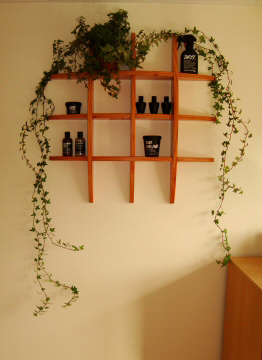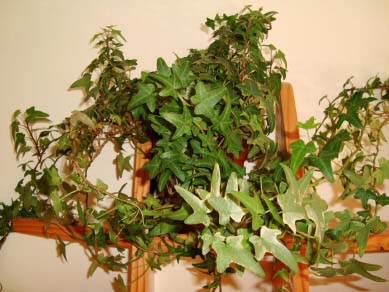





English Ivy or Hendera Helix (which comes from Ancient Greek meaning "twist or "turn") is a very easy house plant to grow indeed, English Ivy is also one of the top plants to filter the air in your home or office. It's likely to be one of the best plants to choose if you want something which clambers over various surfaces and can quickly cover bare surroundings without any help. It also looks good in a hanging basket and can be trained up a moss stick with minimal fuss making it a versatile plant.  All it needs from you in return is a cool environment and a reasonable amount of watering. Therefore it's the perfect guest for the unheated spare room or lonely hallway.
All it needs from you in return is a cool environment and a reasonable amount of watering. Therefore it's the perfect guest for the unheated spare room or lonely hallway.
Some people believe that English Ivy growing outside is a weed, highly poisonous and capable of destroying buildings and for this reason shouldn't be encouraged indoors. This isn't really fair, at least the destroying buildings or poisonous stereotypes. The plant is not capable of bringing down solidly built foundations, although it's clinging aerial roots can push inside cracks of poor construction. It's a rapid grower outdoors and can also topple large tree's from its sheer weight, from this viewpoint you can start to see why it's considered an invasive weed by some.
However all these things apply to Ivy which grows outside, therefore if you would like it as a house plant, which is an enclosed and controlled environment, why not! Bear in mind because of the negative attachments to this plant detailed above you may struggle to find places selling English Ivy if you live in Australia, New Zealand and some parts of the United States.
English Ivy is not Poison Ivy, so it's safe to handle as you would most plants. Its leaves however can be poisonous if ingested, along with the berries that are produced on very mature specimens. Treat it sensibly, i.e. don't eat any parts of the plant, and keep children and pets away, and you won't have any issues.
Light
Generally you can get a variegated or an all green variety or English Ivy. The variegated version needs average to bright light in order to retain its colorings. The all green variety will take darker locations although growth will be slower as a trade off. No direct sunlight for any type however.
Watering
Despite hailing from rainy England, English Ivy dislikes soaking wet conditions or being bone dry. You should be aiming for the middle ground by keeping the soil moist. In Winter the soil will naturally stay moist for longer periods so you will need to water less at this time of the year.
Humidity
If you ignore the temperature warnings below and place the plant in a hot room you will need to mist the leaves regularly or find other ways to keep the humidity high.
Feeding
Feed during the growing season about once every two months with a weak all purpose solution, or one with a high nitrogen content. This is because when it comes to Ivies its often all about the foliage and nitrogen is the primary nutrient to help create this.
Temperature
This Ivy doesn't enjoy very warm temperatures. 10°C - 18°C / 50°F - 65°F is good, warmer than this will cause problems in the long term. Placement in a spare room or isolated kitchen for example would normally be ideal.

Repotting
Due to the effort spent producing aerial roots along its twisting stems, it takes a fair while for English Ivy to fill a normal sized pot with its roots. When you need to repot (perhaps every 2 or 3 years) you can do so at any time of the year using standard soil, or basic potting compost.
Propagation
Remove the tips of the stems (which also encourage bushiness) and these can be used as stem cuttings.
Speed of Growth
Growth will be quick if the light levels are quite bright, things slow down in the cold months of the year or if you have found a dark area of your home for it to live.
Height / Spread
The stems of your Ivy will keep on growing for as long as they have something to grab hold of and so long as you you don't pinch out the tops.
Flowers
Flowers only appear on mature English Ivy plants and rarely indoors. If you do get some however, berries might then appear. These are poisonous so be careful.
Anything else?
If you want a bushier plant you can nip the tips off the growing stems which forces new growth to form lower down the stems.
Copyright © www.100flowers.win Botanic Garden All Rights Reserved